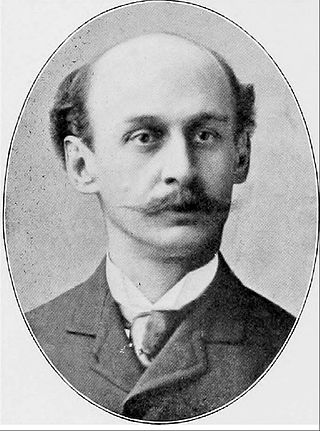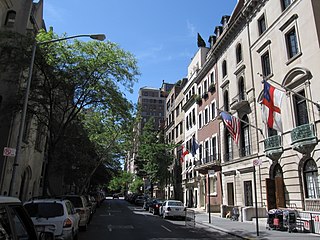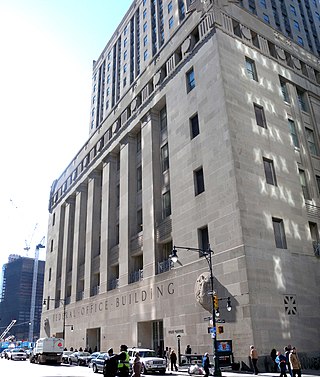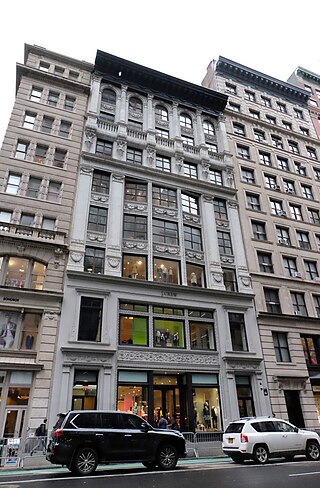
Broadway is a road in the U.S. state of New York. Broadway runs from State Street at Bowling Green for 13 mi (21 km) through the borough of Manhattan and 2 mi (3.2 km) through the Bronx, exiting north from New York City to run an additional 18 mi (29 km) through the Westchester County municipalities of Yonkers, Hastings-On-Hudson, Dobbs Ferry, Irvington, and Tarrytown, and terminating north of Sleepy Hollow.

Fifth Avenue is a major and prominent thoroughfare in the borough of Manhattan in New York City. It stretches north from Washington Square Park in Greenwich Village to West 143rd Street in Harlem. It is one of the most expensive shopping streets in the world.

Henry Janeway Hardenbergh was an American architect, best known for his hotels and apartment buildings, and as a "master of a new building form — the skyscraper."

George Frederick Pelham was an American architect and the son of George Brown Pelham, who was also an architect.

The O'Neill Building is a landmarked former department store, located at 655-671 Sixth Avenue between West 20th and 21st Streets in the Flatiron District neighborhood of Manhattan, New York City. The building was originally Hugh O'Neill's Dry Goods Store, and was designed by Mortimer C. Merritt in the neo-Grec style. It was built to four stories in two stages between 1887 and 1890, to allow the existing O'Neill store to continue operating during construction, with the addition of a fifth floor in 1895, created by raising the pediment. The gilded corner domes of this cast-iron-fronted building were restored c.2000.

West Broadway is a north-south street in the New York City borough of Manhattan, separated into two parts by Tribeca Park. The northern part begins at Tribeca Park, near the intersection of Avenue of the Americas, Walker Street and Beach Street in Tribeca. It runs northbound as a one-way street past Canal Street and becomes two-way at the intersection with Grand Street one block farther north. West Broadway then operates as a main north-south thoroughfare through SoHo until its northern end at Houston Street, on the border between SoHo and Greenwich Village. North of Houston Street, it is designated as LaGuardia Place, which continues until Washington Square South.

The Kitchen, Montross & Wilcox Store at 85 Leonard Street between Broadway and Church Street in the TriBeCa neighborhood of Manhattan, New York City was built in 1861 in the Italianate style for a company which dealt in dry goods. The cast iron for the building's facade came from James Bogardus's ironworks, one of the few surviving buildings for which that is the case. The building's columns are referred to as "sperm-candle style" from their resemblance to candles made from spermaceti.
The design [of the building] combines classically-inspired elements with the non-classical emphasis on lightness, openness, and verticality which characterizes cast-iron architecture.

65 Broadway, formerly the American Express Building, is a building on Broadway between Morris and Rector Streets in the Financial District of Manhattan in New York City. The 21-story concrete and steel-frame structure, an office building, was designed by James L. Aspinwall of the firm Renwick, Aspinwall & Tucker in the Neoclassical style. 65 Broadway extends westward through an entire block, to Trinity Place. Its most prominent feature is its H-shaped building plan, with light courts located between its wings.

The Ladies' Mile Historic District was a prime shopping district in Manhattan, New York City at the end of the 19th century, serving the well-to-do "carriage trade" of the city. It was designated in May 1989, by the New York City Landmark Preservation Commission to preserve an irregular district of 440 buildings on 28 blocks and parts of blocks, from roughly 15th Street to 24th Street and from Park Avenue South to west of the Avenue of the Americas. Community groups such as the Drive to Protect the Ladies' Mile District and the Historic Districts Council campaigned heavily for the status.

The Upper East Side Historic District is a landmarked historic district on the Upper East Side of New York City's borough of Manhattan, first designated by the city in 1981. It was listed on the National Register of Historic Places in 1984. Its boundaries were expanded in 2010.

The Scribner Building is a commercial structure at 155 Fifth Avenue, near 21st Street, in the Flatiron District of Manhattan in New York City. Designed by Ernest Flagg in the Beaux Arts style, it was completed in 1893 as the corporate headquarters of Charles Scribner's Sons publishing company.

Church Street and Trinity Place form a single north–south roadway in Lower Manhattan, New York City. Its northern end is at Canal Street and its southern end is at Morris Street, where Trinity Place merges with Greenwich Street. The dividing point is Liberty Street.

The Sohmer Piano Building, or Sohmer Building, is a Neo-classical Beaux-Arts building located at 170 Fifth Avenue at East 22nd Street, in the Flatiron District neighborhood of the New York City borough of Manhattan, diagonally southwest of the Flatiron Building. Designed by Robert Maynicke as a store-and-loft building for real-estate developer Henry Corn, and built in 1897-98 it is easily recognizable by its gold dome, which sits on top of a 2-story octagonal cupola.

The South Village is a largely residential area that is part of the larger Greenwich Village in Lower Manhattan, New York City, directly below Washington Square Park. Known for its immigrant heritage and bohemian history, the architecture of the South Village is primarily tenement-style apartment buildings, indicative of the area's history as an enclave for Italian-American immigrants and working-class residents of New York.

The Madison Square North Historic District is in Manhattan, New York City, and was created on June 26, 2001 by the city's Landmarks Preservation Commission.

Stephen Decatur Hatch (1839–1894) was a prominent late-19th century architect who was responsible for a number of historically or architecturally significant buildings in Manhattan, New York City and elsewhere. He primarily designed commercial buildings.

935–939 Broadway is a six-story Italianate brownstone structure designed by the architect Griffith Thomas in the Flatiron District of Manhattan, New York City.

9–11 East 16th Street is a seven-story building between Union Square West and Fifth Avenue in the Ladies' Mile Historic District of Manhattan in New York City, just west of Union Square. The building was designed by Louis Korn for Martin Johnson and built between 1895 and 1896.

91-93 Fifth Avenue is an eight-story store and loft building between East 16th Street and East 17 Street in the Ladies’ Mile Historic District of Manhattan in New York City. The building was designed by Louis Korn for Henry and Samuel Corn and built between 1895 and 1896. Previous tenants include the Oxford University Press and Clarendon Press (1905).

889 Broadway, also known as the Gorham Manufacturing Company Building, is a Queen Anne style building located at Broadway and East 19th Street in the Flatiron District of Manhattan in New York City, within the Ladies' Mile Historic District. Built in 1883–1884, it was designed by Edward Hale Kendall.





















